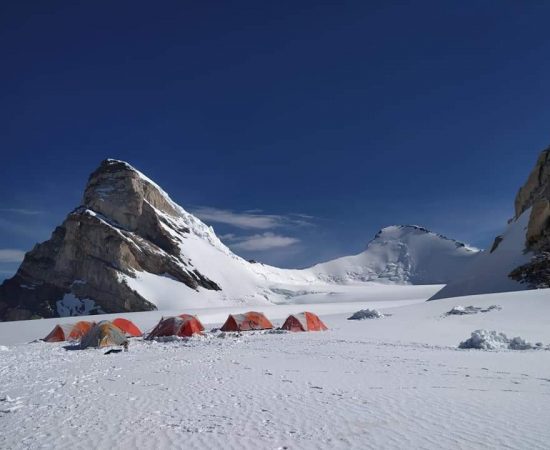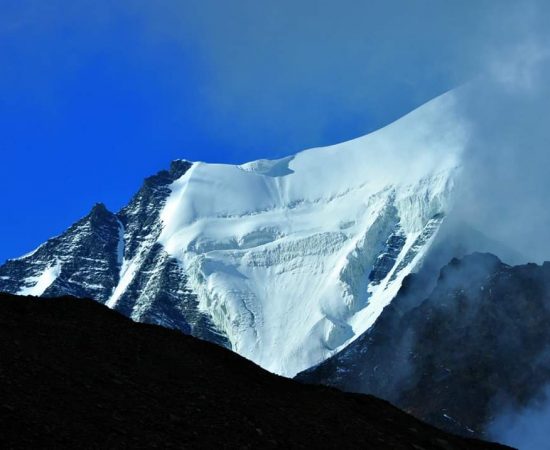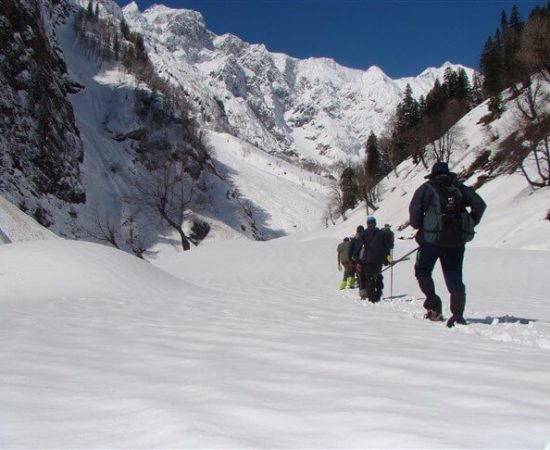Mt. MULKILA CLIMBING EXPEDITION
Lahul, Himachal Pradesh
Rated 4.9/5.0 on TripAdvisor. 550 Reviews


Key Highlights
- Altitude : 6517 mtr
- Time : 21 Days - 20 Nights
- Region: Lahul
- Best Time: August to October
- Grade: Difficult
Overview
Mt. Mulkila Climbing Expedition
Mount Mulkila is one of the ten peaks in the M range that make up the Gems of Lahoul Valley. Central Lahoul, on the Mirang Glacier, is where you'll find the whole range from M1 to M10. The 'M' series of mountains forms a horseshoe around the Mirang Glacier, with its many glacial fingers extending upward into valleys and ridges separating the summits. M4 is a challenging mountain because to its steep ice and the loose rocks that slope tilt up till the summit. In September of 1939, an Anglo-American team made the first successful attempt to climb M4. One of the crew members, Hilda Richmond, was killed by a falling stone while washing in a brook about 500 metres from the base camp, tainting the trip's success. Since then, efforts had been rare, and when they were undertaken, they usually ended in failure because to the presence of hostile circumstances at greater altitudes. Darcha hamlet, just outside of Keylong on the Manali Leh motorway, is where the Mount Mulkila adventure begins. Next, we'll set up several transit camps as we make our way through the little settlement of Yetse and towards the base. The valley further splits at a river junction at around 3500 m in elevation. We'll need to ford this river to reach the northern entrance to Milang Glacier. Read More
Cost Per Person
Key Highlights
- Altitude : 6517 mtr
- Time : 21 Days - 20 Nights
- Region: Lahul
- Best Time: August to October
- Grade: Difficult
Complete
Itinerary of Expedition
We would like to extend to you a warm welcome to India, a place whose culture is deeply rooted in history and whose traditions may be experienced via the mediums of music and dance. Following your arrival at Indira Gandhi International Airport in Delhi, you will be greeted by our representative and given a warm welcome in the customary fashion, complete with garlands. After that, you will be transferred to your hotel, where you will check in and spend the night.
After breakfast in the morning, make your way to the Indian Mountaineering Foundation (IMF), where you will have a briefing with the Director of the IMF and the Liaison Officer, as well as finish some paperwork. The afternoon is yours to spend as you like, so feel free to take advantage of the opportunity to explore the museum and library of the IMF to learn more about the Indian Himalayas and your excursion. Travel in the evening to Manali, overnight travel by bus.
During your full day in Manali, you are going to make a visit to the Hadimba Devi temple. This temple dates back to 1553 and was built in honour of the goddess Hadimba. The temple is home to a number of complex wooden carvings that portray mythical figures and themes of animals and cosmidancers. Then there is Old Manali and Mall road, both of which are places where you may go shopping and eat. Manali hotel room for the night's accommodations.
Check out of your accommodation in the morning after breakfast, and then travel to Darcha. Today, you will go across the Rohtang Pass, which is the highest point on the eastern Pir Panjal Range and measures 3980 metres. Reach in the evening at Darch Spend the night at the guest house that is located in Darcha.
Camping location already setup by our staff, our cooking staff ready with delectable food, (Himalayan Adventure Trips has maintained Cooks, Sherpas & Guiding Staff for years and provide the best possible taste). In the morning, after breakfast, we start our trek towards the base camp of Mount Mulkila. Free time for Leisure in the evening. Overnight at Shikhar Trekking tents. The road head is about 25 km away from the foot of Mount Mulkila.
Following breakfast this morning, we will continue with our walk to the base camp of Mount Mulkila (6517 M), which we will reach later today. Upon arriving, we set up camp for the night so that we could remain there.
The next 12 days will be spent creating higher camps and climbing the peak.In preparation for the summit, we set up two high camps. The Mulkila 5,6, and other Lahaul Valleys are seen from the peak of the mountain. Because Himalayan Adventure Trips places an emphasis on safety above all else, we make our sherpa walkie talkie and satellite phone available to you at all times so that you may stay in contact with us. After reaching the summit, make your way back to Base Camp the next day after descending to Camp 1. overnight stays at several camps.
After breakfast, begin your descent to the Korjok settlement where you will spend the night in either a tent or a house.
Following breakfast, we will get back on the road and go to Manali. Upon arriving in Manali, check into the hotel where you will be staying for the night.
After breakfast, check out of the hotel and travel to Delhi and and our airport transfer will take you to the Indira Gandhi Airport so that you may continue on to your next destination. It was a pleasure to meet you and have you visit India. I hope to see you again soon.
Enquiry For Group Bookings
Guidelines
➽ Preparation for Expedition
As you well know, the great Himalayan expedition is one that requires careful preparation, a strategy that allows for enough flexibility to adapt to whatever challenges may arise.
Therefore, here are some things to consider before setting out on your Mt. Mulkila Climbing Expedition:
⦿ Physically – You should start working out at least a month before signing up for a program if you want to be physically prepared for the rigours of a journey. Strengthen your legs by jogging and working out regularly to increase your stamina. To better acclimatise to the environment and increase your resilience on the walk, you should give up smoking and undertake breathing exercises twice a day. Engage in vigorous physical activity, such as playing sports, doing Yoga, or running.
⦿ Mentally –
Getting in shape physically is essential, but mental preparation is just as crucial for a successful walk. Take time to enjoy your regular activities, maintain a healthy diet and sleep schedule, and unwind before embarking on a hike. Predictions regarding the journey should not cause mental worry. Spend time with your closest pals to recharge your batteries and renew your spirit. Pre-trek preconceptions are unwarranted since the first contact with the other trekkers is certain to be a source of inspiration and energy. Conditions during the walk will contribute to the increase in mental readiness. The mental repercussions of physical disadvantages will not be ignored. So, when you hike, pay attention to different regions of your body and purposefully relax them. If you want to enjoy your hike, you should learn to loosen up a little, particularly in the hips. Think about your descent as a simple dance, and enjoy the natural rhythms that the path and your body can discover together gradually, whether you're on a flowing downhill route or a frightening slope. Try out a few new walking techniques to add some fun to your commute without worrying about getting somewhere in particular. Maintaining mental fitness mostly requires a willingness to relax and take in the journey, rather than subjecting oneself to undue stress.
Guidelines
➽ Things to Carry
- Good Trekking Boots: You need sturdy trekking boots with supportive high ankles. Don't bring your running shoes. U can carry extra floaters/flip flops also.
- Wear warm clothing, such three-layer coats, fleece upper, hollow fill or down-filled jackets. Carry full-sleeved T-shirt. Carry cotton hiking trek pants and warm pant for your lower body. Never bring shorts or jeans on a hike.
- Take top and bottom thermals with you.
- Quick dry towel with light weight and Personal toiletries. Suns cream lotion, sanitizer, tooth brush ad toothpaste, lip balm and antibacterial powder.
- Socks: Bring two pairs of regular socks and two pair of wool socks for wearing at night.
- A head torch is required.
- Sunglasses/ Goggle: UV-protected sunglasses are necessary to protect against sunlight and Snow Mountain.
- There should also be a woolen cap / balaclava, cap, neck gaiter cum face mask and warm fleece and waterproof summit gloves since it will be chilly. Keep waterproof gloves on hand since they become wet in the snow.
- Everyone taking part in the activity should have their own lunchbox, spoon, mug and water bottle/ hydration pack of 2 ltr.
- Raincoats/ponchos: Since snowfall and rain are frequent at high elevations, it is important to have one on hand so as to avoid getting wet.
- Trekking bag of 75 ltr with rain cover.
- Walking stick.
- Personal first aid box. Emergency ration, energy bars, dry fruit, electoral/Ors
- Personal technical gears list of mountaineering (on rent basis available)
- Climbing boot, Crampon, Sleeping bag (optional), Ice axe, seat harness, Rope and tape sling, helmet, Summit gloves, Gaiters, Carabineers 2 no (screw), figure of eight/descendor, Zumar (Ascendor),
- Required Documents:
a) Registration Form
b) Medical Certificate (signed by a licensed MBBS physician)
c) NOC form (completed by the trekker)
d) 2 passport-size photos
e) ID Proof photo (not PAN)
f) Basic Mountaineering Course certificate.
g) Insurance upto 5 lac..
Guidelines
➽ How to Reach
How to reach Manali:
Delhi and Manali are linked nicely. You may travel from Delhi to Manali in 12 to 14 hours via overnight bus (approx 540 KMS). Online ticket reservations are available at www.redbus.in and www.hrtc.gov.in Tip: Given the distance between Delhi and Manali, the majority of Volvo private buses depart Delhi between 5 and 8 p.m. At 8.30 p.m., the final government bus departs from ISBT Kashmere Gate. Between Rs. 1,200 and Rs. 1,800 are charged by Volvo buses each sector from Delhi to Manali and vice versa. Delhi to Manali: Buses depart from Manali for Delhi between 4 and 8 p.m., same like the return trip. You should expect to arrive in Delhi any time between six and ten in the morning. Plan your subsequent trips just after midday, leaving ample time for bus delays.
How to reach Naggar:
Naggar is 18 kilometres from Manali, and there are several buses that operate every 15 minutes. Alternatively, one may get out at Patlikuhal, which is 5 kilometres from Naggar on the right bank highway. Between Kullu and Manali is Patlikuhal. To get to Naggar, you may take a cab or a local bus from Manali or Patlikuhal.
The closest train station is:
Ambala (350 miles) and Chandigarh are the closest railway stations (310 kms). Advice: From Chandigarh to Manali, regular buses and Volvos run in the evening. Volvo buses from Chandigarh to Manali and vice versa charge between Rs. 800 and Rs. 1,200 every sector.
The closest airport:
The closest airport to Manali is Bhuntar, which is 52 kilometres distant. From Bhuntar to Manali, taxi services are available and cost between Rs. 1500 and Rs. 2,500. Air travel between Bhuntar and Delhi is convenient. Airlines providing flights from Delhi and Chandigarh to Kullu include Indian Airlines, Kingfisher Airlines, MDLR Airlines, and Jagson Airlines.
➽ Trip Cost Includes
- Mountaineering (Instructor/guide) services provided by a highly trained, professional, and qualified Himalayan Adventure Trips staff.
- Certified local guide with extensive familiarity of the area.
- Climbing provides only vegetarian food (breakfast, lunch, and dinner).
- Staff include chefs, cooks, and helpers.
- High Altitude Force, Low Altitude Force, Porters, Mules for Common Equipment (Rations, Tents, Utensils, Central Climbing Equipment, etc.)
- Tents (to be shared), sleeping bags, air mattresses, and air pads are included. Inner
- We offer twin-share accommodations in dome, alpine, and high-altitude tents on all of our treks and expeditions. All necessary camping equipment, including air mattresses, a shelter for cooking and eating, a table and chairs, a stool, and more, would be supplied.
- Someone who can carry heavy items, set up high camps, repair ropes, etc. at high altitudes.
- Assistance from Guide All the Way to the Top
- High-altitude butane gas cooker
- The only meal offered at the hotel will be breakfast. All meals while on the walk will be supplied for you. Indian, Chinese, and Continental cuisines, all freshly cooked, will be on the menu.
- Tin-packaged food is what we'll eat at high altitude.
- A standard first aid kit with oxygen masks for the patient.
- Camping fees, wildlife fees, and forest permits.
- Taxes imposed by the state.
➽ Trip cost Excludes
- Climbers may hire individual porters to carry their gear.
- Airport transportation costs
- Expenses for carrying still/video cameras etc.
- Irregular/Personal costs, such as laundry, phone calls, and gratuities.
- Climbing equipment such as ropes, pitons, snow bars, crabs, etc.
- Your own personal mountaineering equipment and clothes, as well as any specialised foods you may need
- Inner Line Permit.
- Health coverage or the price of a rescue mission
- Expenditures of a more personal character (such as booze, soda, bottled water, mineral water, canned or bottled drinks, candy, canned or packaged dried fruits, etc.)
- Provisions/food to or from the starting point of the trek.
- Any expenses that are incurred as a result of natural disasters, human error, or other unforeseeable occurrences.
- Protect your trip with a travel insurance policy.
- Authorization, licensing, and enlistment with the IMF.
- Payment for Liaison Officer (included for foreign expedition only)
- GST of 5%.
Guidelines
➽ Special Casual Leaves
Government employee can avail the benefit of special casual leave when u join us for a trekking expedition. As per the rule of the pay commission, special casual leave can be availed for up to 30 days in a calendar years for trekking and mountaineering expeditions through a register organization. Himalayan adventure trips are a register adventure tour operator register with Indian mountaineering foundation and Himachal Pradesh tourism. Candidates have to apply for leave at least 30 days before the trek/expedition start.
Testimonials
➽ Provided By The Customers
Climbing Hanuman Tibba in August 2019 with Good Company
In the company of Hat, Sameer, Arun, and I climbed to the summit of Hanuman Tibba (at an altitude of 5932 metres). With Shera at the helm as the chief guide, along come Vishal, Panna, and Jaggi, who work together to form a tight-knit, effective, and amiable unit. The majority of our time was spent in a high-quality 4-person tent; the given gear was not brand new but adequate, with the exception of a few small difficulties with one of the sleeping bags. Both the meal and the hot beverages were delicious. Manu was simple to get in touch with before to our adventure, and he answered all of our questions (there weren't many) thoroughly. Basically, my time spent on adventure with Himalayan Adventure Trips was both personally rewarding and professionally enriching.
How useful was this post?
Click on a star to rate it!
Average rating 0 / 5. Vote count: 0
No votes so far! Be the first to rate this post.





